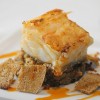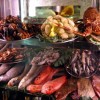- Accede I
- Regístrate I
- carrito
Del mar a la tierra
Merluzas, rodaballos, meros, lubinas, lenguados, besugos y rapes son los pescados de las aguas gallegas que ‘nadan’ en las cartas de un auténtico mar de restaurantes. Las sardinas y jureles van, por excelencia, fritos; el resto admite desde un sencillo paso por la plancha o el horno hasta suculentos guisos ‘a la gallega’ –con ajada, aceite de oliva y abundante pimentón–, en caldeirada y ‘en zarzuela’, lo que ya implica la presencia en la olla de varias especies, patatas, judías o guisantes y la apreciable escolta de langostinos o almejas. De los mil ríos gallegos llegan además salmones, truchas y lampreas.
La capital de Galicia es también escenario para la degustación de la famosa ternera gallega, que brinda churrascos, solomillos y chuletones de considerable ternura y tamaño. Pero el gran protagonista de los platos de invierno es, muy a su pesar, el cerdo. A partir de su matanza en noviembre –’a todo porco lle chega o seu san Martiño’– aparece en preparaciones como el lacón con grelos (los brazuelos delanteros del animal curados y servidos con patatas, chorizo y hojas tiernas de nabo) o en el cocido gallego, que combina carne fresca, gallina, chorizo, lacón, costilla salada, tocino, oreja y morro porcino con patatas, garbanzos y grelos.
Morcillas y chorizos pueden además presentarse rellenando las filloas, que aparecen en la gastronomía gallega a tiempo para la matanza y el Carnaval, solas o acompañando al cocido. Se trata de unas tortillas, semejantes a las crêpes bretonas, que también son muy populares en su versión dulce.














